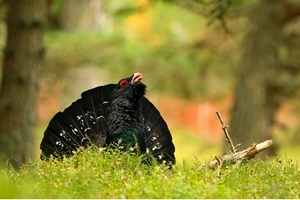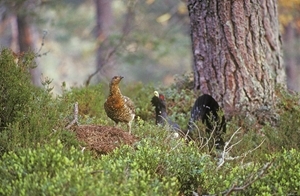Key points
- Capercaillie are a red-listed species found in old pine forests in Scotland, with populations declining since the 1970s despite efforts to help them.
- National surveys are completed every six years, but annual lek and brood counts may be able to produce robust population estimates in the interim.
- Annual population sizes were estimated between 2010 and 2020 from annual counts of males at lek sites, and counts of adults and broods in August combined with published survival rates.
- The Scottish population was estimated to be 580 birds in 2011, falling to 304 birds by 2020.
- Around 83% of remaining males reside in the Badenoch & Strathspey area, following large declines in Deeside & Donside, Morayshire & Ross-shire, and Perthshire & Trossachs.
- By 2020, the risk of extinction was 23% after 25 years, 95% after 50 years and 100% after 100 years.
- Removing deaths caused by fencing lowered the risk of extinction to 0%, 3% and 40% within 25, 50 and 100 years respectively, highlighting fence removal as a management priority.
Background
 Capercaillie are iconic birds found in old pine forests in the Scottish Highlands and other parts of central and western Europe. Once a hunted gamebird, they are now protected and red-listed in many parts of their range due to large population declines. The species went extinct in Scotland in the late 18th century but was successfully reintroduced in the 1830s.
Capercaillie are iconic birds found in old pine forests in the Scottish Highlands and other parts of central and western Europe. Once a hunted gamebird, they are now protected and red-listed in many parts of their range due to large population declines. The species went extinct in Scotland in the late 18th century but was successfully reintroduced in the 1830s.
In Scotland, the distribution and number of capercaillie has declined since the 1970s. The decline has been associated with intensified forest management, increases in predator numbers, changes in weather patterns, and collisions with deer fences. The main demographic change during the decline has been reduced breeding success.
The first national transect-based surveys in winters 1992-94 estimated there were 2,200 birds in Scotland. Since then, surveys repeated approximately every six years suggest that the population has fluctuated around 1,000-2,000 birds, with a figure of 1,114 in 2016. These estimates were based on a small number of observations with varying detection rates, and hence can be imprecise. However, the 51% decline in capercaillie observed from 1994 to 2016 is the highest long-term decrease seen in any bird species in Scotland. These declines have occurred despite efforts from land managers to control predators, manage habitat, and mark and remove deer fences.
What they did
 Given that national surveys are expensive to complete, only take place every six years, and produce results of low precision, GWCT scientists considered whether annual counts of males at leks and counts of adults and young in August, combined with published survival rates, could be used to produce accurate annual population estimates.
Given that national surveys are expensive to complete, only take place every six years, and produce results of low precision, GWCT scientists considered whether annual counts of males at leks and counts of adults and young in August, combined with published survival rates, could be used to produce accurate annual population estimates.
Data were available from 151 known leks in Scotland in Deeside & Donside, Moray & Ross-shire, Perthshire & Trossachs, and Badenoch & Strathspey between 2010 and 2019. Of these, 110 were occupied in any one year within the period. Leks were visited in late April or early May between 04:00 and 08:00, when bird activity was highest. All males seen or heard were counted. The number of occupied leks and the number of males using them was totalled for each year, and in 2011 and 2016 totals were compared with data from national surveys in the previous winter.
Adults and broods were surveyed in five forests in Strathspey every August. In most years, the same three observers walked the same parallel transects, each using a trained dog to locate birds and broods. It was not possible to distinguish between females that had not bred from those that had tried and failed, so all females encountered were included in calculations of breeding success. Statistical models were used to estimate the population size and the likelihood of extinction within 25, 50 and 100 years based on a range of factors, such as the presence or removal of fencing.
What they found
The predicted annual number of males in Scotland declined by an average of 2.9% a year during the ten-year study period, with the biggest declines occurring between 2015 and 2019.
In Deeside & Donside and Morayshire & Ross-shire, the number of males halved between 2010 and 2019; in Perthshire & Trossachs only one male remained by 2019; and in Badenoch & Strathspey the number of males initially increased in the first part of the decade, but then decreased from 2015. The average number of males attending leks decreased from 2.7 per lek in 2010 to 1.8 per lek in 2019. Across the study period, the proportion of single-male leks increased from 29% to 55% of leks, with small leks (attended by 2-4 males) falling from 47% of leks in 2010 to just 20% by 2019. Additionally, between 2010 and 2019, the proportion of the national population found in Badenoch & Strathspey increased from 68% to 83%.
Between 2010 and 2019, 792 females with 503 chicks were observed on 45 brood surveys: an average of 0.6 chicks per female. Of the 247 chicks old enough to be reliably sexed, 41% were male. Additionally, 531 adult males were observed on 32 of the brood surveys, giving a sex ratio of 1.04 females per male. Breeding success between 2010 and 2020 varied across the study forests in Badenoch & Strathspey from 0.52 chicks per hen to 0.98, and showed a progressive overall decline across these forests from 1.24 chicks per female 2010 to 0.05 in 2020.
What does this mean?
The estimated population size of capercaillie fell from 580 birds in 2011 to just 304 birds by 2020, representing a 48% decrease in the Scottish population. Earlier studies have clearly shown the impact that collisions with deer fences can have on capercaillie, so population sizes with and without fences were calculated. Estimates were 16% higher when deaths caused by fences were removed. When including deaths caused by fences in the analysis, the likelihood of extinction was 23% after 25 years, 95% after 50 years, and 100% after 100 years. Without deaths caused by fences, the likelihood of extinction was 0%, 3% and 40% within the same time periods, highlighting that fence removal must be a high priority to save the capercaillie.
Due to their aggressive seniority, older dominant males display to females from the centre of leks, with younger males restricted to the peripheries or not attending leks at all. Thus, counts based on males at leks may be incomplete and resulted in lower estimates in this study than those from the national transect surveys in 2009/10 and 2015/16. The scientists also assumed that leks found during the study period had been present from the start, whilst other leks may have gone extinct before they were detected. To make population estimates based on lek-counting methods more accurate, multiple counts should be conducted at the same leks each year. This should be combined with brood surveys to monitor breeding success.
Capercaillie breeding success is now notably lower in Badenoch & Strathspey than it was during the period 1991-2009 when the GWCT last published breeding data. Brood monitoring should be restored in forests where it has recently been stopped to provide better estimates of productivity.
This population estimate study, alongside the results of national surveys, show that Badenoch & Strathspey remains the most important stronghold for capercaillie, and there is urgent need for conservation action here to prevent a second extinction of the species in Scotland.
Read the original paper
Baines, D. and Aebischer, N. (2023) Estimating capercaillie Tetrao urogallus population size in Scotland from annual leks and counts of broods over the period 2010–2020. Wildlife Biology, 3.